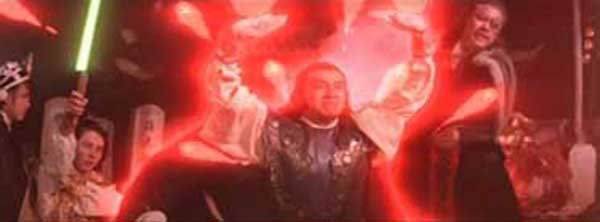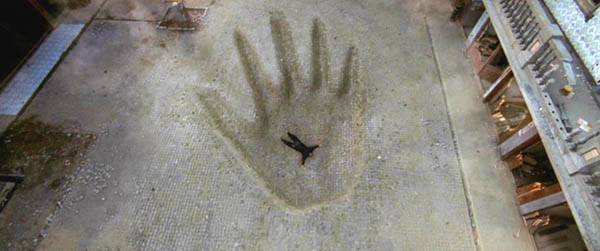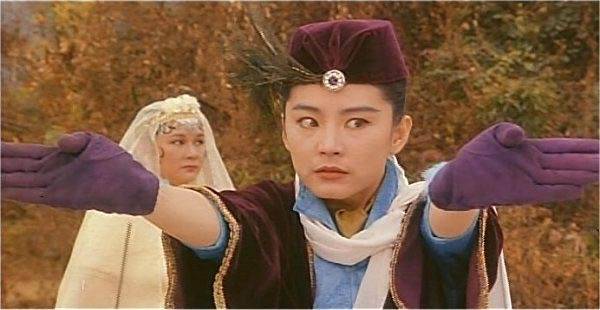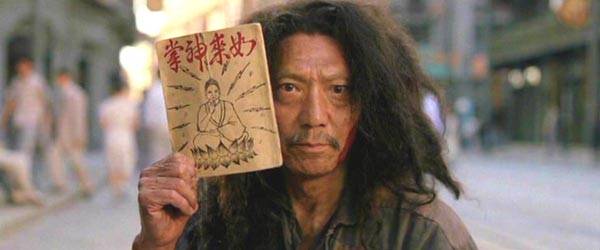After the defeat of the musicians, the landlady ends up in a car with the Axe triads. Imitating Bruce Lee, she shakes her finger in the leader's face, makes a fist, and cracks her knuckles to warn him of her invincibility without speaking. With the introduction of the Beast, the next major opponent in the film, the references to Bruce Lee increase exponentially. In the early 1970s, Bruce Leung Siu Lung(Hsiao Liang), who plays the Beast, along with Bruce Lee and Jackie Chan, was a popular star in Hong Kong martial arts cinema. While Bruce Lee's character had trouble with a Western toilet seat in The Way of the Dragon/Return of the Dragon (1972), the Beast is introduced in Kung Fu Hustle seated comfortably on the toilet of his prison cell. While Lee's character in Fist of Fury is killed by a volley of bullets, the Beast's initial act of kung fu in Kung Fu Hustle is capturing a speeding bullet between his fingers (also, an oblique reference to the Boxers' claim that their kung fu could defeat Western guns in their 1900 rebellion). When the landlord and landlady combat the Beast at the triad casino, references to the 1970s abound--from polyester stretch pants and striped bell bottoms to a final game of “Twister” with three-way joint locks. However, just as statues of Guan Gong/Kwan Yu (the legendary general and patron god of martial arts) and Buddhist shrines compete in the mise-en-scene with Hollywood film posters and advertisements for patent medicines, this scene also features the traditional prop of a “zhong” (bronze bell), which the landlady uses to accentuate her powers. Since the sound of the word “zhong” (“clock” or “bell”) resembles the sound of the word for “terminus” or “end” in Chinese, clocks and large bells are associated with death. When the bell appears in the casino, it is not a good omen, and Sing, unexpectedly changing sides in the battle, takes the brunt of it.

Like House of Fury (which had its premiere as part of the HKIFF), Kung Fu Hustle also features a depiction of traditional Chinese medicine as part of the martial arts practitioner's knowledge. The landlord and landlady attempt to heal the battered Sing with herbal remedies. Wong Fei-hong had no monopoly on martial arts-cum-medicinal claims, since martial arts practices have health benefits (e.g., tai ji chuan , qi gong , etc.) and martial artists had to fix whatever they may break on their own or each other's bodies with herbal remedies, etc., since they were historically outside of the legal establishment. However, the Wong Fei-Hung/Kwan Tak Hing series really helped to make the martial arts doctor a standard part of the genre.
This is another way in which Chow transposes The House of 72 Tenants from a slum comedy into a martial arts fantasy. In the comedy, the doctor (apparently a practitioner of Western medicine trained in the North) appears as a new resident of the tenement, anxious to build his clientele, and hampered by a pair of ruined trousers. However, this figure is not among the Pig Sty Alley residents. Rather, the role of doctor becomes part of the generic make-up of the kung fu genre through the re-imagination of this narrative function through the landlord and landlady as martial arts healers in hiding. As Sing recovers, a shot of an acupuncture dummy and a cut to a butterfly emerging from its chrysalis while music resembling “Under the General's Orders” plays on the soundtrack pay tribute to Kwan Tak-Hing/Wong Fei-Hung in no uncertain terms.

Buddha's Palm
Of course, when he emerges, Sing fights like Chow's hero Bruce Lee, beginning, as Lee did, with Wing Chun stances, short range punches, and low kicks, and expanding out to Lee's eclectic and distinctive blending of global martial arts with expansive long range kicks and digitally enhanced aerial maneuvers. He then moves into the flying “qing gong” popularized by Yuen Wo-Ping in films like Crouching Tiger, Hidden Dragon (2000) and The Matrix (1999)—flying around the tenement courtyard and eventually into the heavens where he encounters an image of Buddha—and remembers the Buddha Palm he had rejected as a child. Many classic kung fu films refer to the Buddha Palm as a mystical combination of spiritual strength and physical power. Stephen Chow enjoyed a series of films based on the idea of Buddha Palm produced in Hong Kong in the 1960s and reprised by Shaw Brothers in Buddha's Palm (1982). The technique itself forms an important part of the Southern systems of Choy Li Fut and Hong Fut—the “fut,” in each case, refers to the Buddha—which draws on “internal” exercise to muster “qi.” While the massive palms that shatter buildings and form craters in Pig Sty Alley have more to do with Hong Kong martial arts fantasies than with Chinese martial arts traditions, the use of the technique still has its roots in living kung fu systems practiced today.

While the toad style of the Kwan Lun/Kunlun Mountains School may seem a fittingly far-fetched and fanciful style for the climax of Kung Fu Hustle, it, too, has roots in both martial arts fact and fantasy. The toad does inspire several “animal” techniques common to Chinese kung fu, and the toad stance became famous in Louis Cha/Jin Yong's martial arts novel, The Eagle Shooting Heroes, which was the basis for the film of the same title by Jeff Lau (1993) and Wong Kar Wai's Ashes of Time (1994). The Kunlun Mountain range in Western China , moreover, is the home to a number of traditional kung fu styles. Combining the “toad” stance with the Kunlun Mountains does ring true within the fantasy world of the martial arts films and does not ring unduly false within the world of the kung fu practitioner. The greatest acknowledgement for a “kung fu genius” is to have another martial arts master kneel at his feet and ask to be his pupil, particularly when the “master” had been one of Bruce Lee's competitors and the “genius” pays homage to Lee by taking on his screen persona. The greatest tribute that can be paid to a kung fu film is a seal of authenticity based on martial arts tradition.

Eagle Shooting Heroes
After the Beast's defeat, Chow has been visually transformed into Bruce Lee—black Chinese kung fu trousers, black sash, and naked from the waist up. Comparing Kung Fu Hustle's climax to the penultimate scene of Bruce Lee's Fist of Fury/Chinese Connection (Lo Wei,1972) highlights the debt Stephen Chow owes to Lee, but also the fundamental differences between the two. At the end of Fist of Fury, a freeze frame captures Lee executing an aerial kick as his last defiant gesture before being gunned down by the Japanese. Although Lee's character may have avenged the master's death and his final leap may immortalize him as a hero, it does not allow him to continue his master's lineage. Sing, on the other hand, embodying a new Bruce Lee, takes on a master as student. However, Sing represents no earthly tradition, no Confucian lineage, no “kung fu” earned through the hard work demonstrated in The Story Of Wong Fei-hung : Part I. Rather, through computer graphics, Sing/Chow ascends into the heavens, becomes enlightened, and drifts down to earth as a “master” of the Buddha's Palm—a spiritual art divorced from its actual martial arts heritage. He fulfills the prophecy of the beggar who hustled him into buying the Buddha's Palm manual when he was a kid. At that time, kung fu only brought insult, injury, and humiliation, and Sing took up the “hustle” to become a thief rather than the “kung fu” to become a master. Unlike Bruce Lee who championed physical training and mental discipline that transcended traditional styles, Stephen Chow celebrates the magic of the cinema and the digital revolution—a “master” not bound by the limitations of the human body.

If Fist of Fury conjures up nostalgia for the heroism of pre-1937 Shanghai and a time when kung fu masters mattered, then Kung Fu Hustle alludes to a different sort of nostalgia for kung fu films of the 1970s that take as their subject colonial Shanghai. The Story Of Wong Fei-hung : Part I needed to rely on actual Hung Gar practitioners to legitimate its connection to Wong Fei-Hung and provide a suitable fantasy for diasporic Chinese hungry for nostalgic reminders of the “good old days” in Canton. Fist of Fury conjured up old Shanghai to place the new rebellious 1970s hero within the proper tradition of Chinese martial artistry. In fact, Bruce Lee embodied the contradiction between the kung fu establishment and the more rebellious younger generation of martial artist who found the old systems and forms confining. As a martial artist, Bruce Lee made his reputation as a master of the style-less style, Jeet Kune Do, the “way of the intercepting fist,” which drew on an eclectic blend of Wing Chun, Western boxing and fencing, Philippine arnis/kali/escrima, and other arts to form a new martial core. For the on-screen Lee, lineage mattered, but was doomed to die. For the off-screen Lee, kung fu needed to move beyond the prison of tradition.
|
